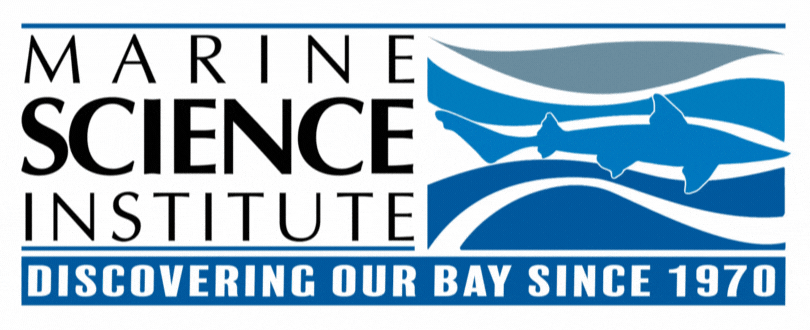
INLAND VOYAGE
Monday - Saturday
50 minutes per session
Grades K and up
Max 30 students
per session
Inland Voyages deliver living marine animals directly to the class with the Marine Science Institute’s mobile aquarium. Students learn about local marine environments and the organisms that live in them through a combination of hands-on investigation and inquiry-based learning activities. We offer seven different program options focused on habitats or animals, which can be customized with a theme to fit each class’s needs.
50 Minute Programs
Inland Voyage Pricing
50 Minute Programs
Select one topic per session, up to two different topics per day
Can accommodate up to 30 students per session
Maximum 5 sessions per day
Sep. - Feb. Pricing
$595*/base price for 1 - 3 programs
plus travel fee of $1.25/mile outside of Redwood City
$199* for each additional program, up to 5 programs
Mar. - Aug. Pricing
$600*/base price for 1 - 3 programs
plus travel fee of $1.25/mile outside of Redwood City
$199* for each additional program, up to 5 programs
*Sliding scale available depending on need.
All school programs are automatically subsidized. Our development team works hard to secure funds for teachers. If you need additional financial assistance please contact us. We may be able to offer extra scholarships.
Click here to start the additional sponsorship process.
Session Topics
Teacher may select up to 2 different topics to be presented in one day
Each 50-minute session explores ONE of the marine science topics below:
Bay Fish (bony fish & sharks)
Students closely observe and touch live fishes and a leopard shark from the San Francisco Bay Estuary. They compare and contrast bony and cartilaginous fishes, and the adaptations that help them to survive in an aquatic environment.
Bay & Ocean Invertebrates
Students explore and examine invertebrates found in the San Francisco Bay Estuary and Pacific Ocean. They touch and identify creatures from each habitat and compare and contrast the animals’ adaptations for survival in their respective environments.
Marshes & Mudflats
Students discover the importance of salt marsh habitats to the San Francisco Bay ecosystem and to the migratory birds that use them. They also explore the fishes and invertebrates that rely on mudflats, and the relationship between the marshes and mudflats.
Rocky Intertidal (bony fish & invertebrates)
Students focus on the influences of tides on the rocky shore, and the animals that survive in the harsh conditions of the tidepool habitat. They handle live fishes and invertebrates, and examine how they are adapted to life in the rocky intertidal.
Marine Mammals
Students discover what all mammals have in common, and how marine mammals are uniquely suited to surviving in aquatic environments. They explore artifacts and discuss the feeding and survival strategies of different types of mammals.
Sandy Beach
The Sandy Beach habitat-focused program examines on life above and below the sand. Students learn how animals like sea turtles use the beach to lay their eggs, while others such as snails and sand crabs rely on the protection of burrowing beneath the sand.
Kelp Forest
Students study the structure of kelp, and about the rich community that depends upon kelp forest habitat. They touch live animals and explore artifacts that demonstrate the importance of kelp both ecologically and for human uses.
Forms and Information
NGSS Connections (Science Content Standards Set by CA Sate Education Board for Public Schools)
Fish and Sharks
K - 2nd Grade Disciplinary Core Idea's (DCI): LS1.A, LS1.B, LS1.C, LS1.D, LS3.B, LS4.D, ESS2.C, ESS3.A, ESS3.C, ETS1.A
3rd - 5th Grade DCI: LS1.A, LS1.B, LS1.C, LS1.D, LS2.A, LS2.B, LS2.D, LS3.A, LS4.B, LS4.C, LS4.D, ESS3.C
6th - 8th Grade DCI: LS1.B
Rocky Shore
K - 2nd Grade DCI: LS1.A, LS1.B, LS1.C, LS1.D, LS3.B, LS4.D, ESS1.A, ESS1.C, ESS2.C, ESS2.D, ESS2.E, ESS3.A, ESS3.C, PS3.B, ETS1.A
3rd - 5th Grade DCI: LS1.A, LS1.B, LS1.C, LS1.D, LS2.A, LS2.B, LS2.D, LS3.A, LS4.B, LS4.C, LS4.D, ESS3.C, PS2.B, PS4.A
6th - 8th Grade DCI: LS1.B
Bay and Ocean Invertebrates
K - 2nd Grade DCI: LS1.B, LS4.D, ESS1.C, ESS2.C, ETS1.A
3rd - 5th Grade DCI: LS1.A, LS1.B, LS1.C, LS1.D, LS2.A, LS2.B, LS2.D, LS3.A, LS4.B, LS4.C, LS4.D, ESS3.C, PS2.B
6th - 8th Grade DCI: LS1.C, LS2.A, LS2.B, LS2.C, LS4.C, LS4.D, ESS3.C
Kelp Forest
K - 2nd Grade DCI: LS2.A, LS4.D, ESS1.C, ESS2.C, ETS1.A, ETS1.B
3rd - 5th Grade DCI: LS1.A, LS1.B, LS1.C, LS1.D, LS2.A, LS2.B, LS2.D, LS3.A, LS4.B, LS4.C, LS4.D, ESS3.C, PS3.D, PS4.A
6th - 8th Grade DCI: N/A
Marine Mammals
K - 2nd Grade DCI: LS1.A, LS1.B, LS1.C, LS1.D, LS3.B, LS4.D, ESS3.A, ETS1.A
3rd - 5th Grade DCI: LS1.A, LS1.B, LS1.C, LS1.D, LS2.A, LS3.A, LS4.B, LS4.D
6th - 8th Grade DCI: N/A
Marsh and Mudflats
K-2nd Grade DCI: N/A
3rd - 5th Grade DCI: LS1.A, LS1.B, LS1.C, LS1.D, LS2.A, LS2.B, LS2.D, LS3.A, LS4.B, LS4.C, LS4.D, ESS1.B, ESS1.C, PS2.B
6th - 8th Grade DCI: N/A
Sandy Beach
K - 2nd Grade DCI: LS1.A, LS1.B, LS1.C, LS1.D, LS3.B, LS4.D, ESS1.A, ESS1.C, ESS2.C, ESSW2.D, ESS2.E, ESS3.A, ESS3.C, ETS1.A
3rd - 5th Grade DCI: LAS1.A, LS1.B, LS1.C, LS1.D, LS2.A, LS2.B, LS2.D, LS3.A, LS4.B, LS4.C, ESS3.C, PS2.B, PS4.A
6th - 8th Grade DCI: N/A
